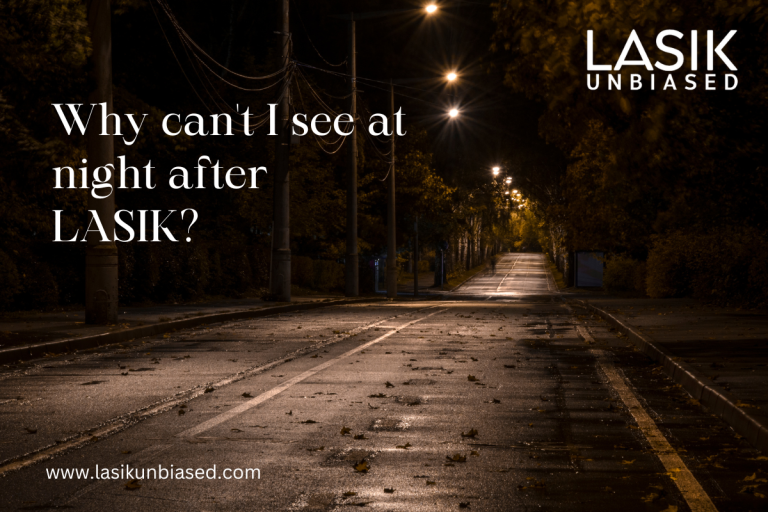LASIK surgery provides a life-changing improvement in vision, offering freedom from glasses and contact lenses. While most patients achieve clear vision quickly, some experience temporary difficulties with night vision.
Issues such as glare, halos, and starbursts around lights are common in early recovery. Understanding why these night vision problems occur and how they resolve over time can help patients manage their expectations and recovery effectively.
Causes of Night Vision Problems After LASIK
Night vision disturbances after LASIK typically stem from the healing process of the cornea. During LASIK, a flap is created on the corneal surface, and the underlying tissue is reshaped to correct refractive errors. As the eye heals, it undergoes changes that can temporarily affect how light is processed, leading to visual disturbances in low-light conditions.
One of the primary reasons for night vision difficulties is increased light scattering. When the corneal tissue is reshaped, minor imperfections can create irregularities in how light enters the eye. This effect is more noticeable in dim environments, where the pupil dilates to allow more light in, amplifying glare and halos around bright objects.
Another contributing factor is dry eyes, a common temporary side effect of LASIK. The surgery affects the nerves responsible for tear production, reducing moisture on the eye’s surface. A lack of lubrication can cause light to scatter unevenly, making it harder to see clearly in the dark.
Common Night Vision Disturbances
Many LASIK patients report experiencing specific night vision issues, including glare, halos, starbursts and reduced contrast sensitivity. Glare occurs when bright lights appear excessively intense, making it difficult to see in their presence. Halos manifest as rings around light sources, such as streetlights or headlights, which can be distracting while driving at night.
Starbursts resemble radiating light patterns, often seen around headlights and illuminated signs. This effect can be disorienting and may cause discomfort during nighttime activities. Reduced contrast sensitivity makes it harder to distinguish objects in low-light environments, leading to difficulties with depth perception and overall clarity.
Duration of Night Vision Issues
For most LASIK patients, night vision problems are temporary and improve as the eyes heal. The first few weeks post-surgery are when these disturbances are most noticeable. By three to six months, most patients experience significant improvement as their corneas stabilize and the nerve regeneration process restores normal tear production.
In rare cases, some patients may experience mild night vision disturbances beyond six months. However, advancements in LASIK technology, such as wavefront-guided treatments, have significantly reduced the likelihood of long-term night vision issues.
Managing Night Vision Difficulties
There are several ways to manage night vision problems while the eyes heal. Using lubricating eye drops helps combat dryness and improves visual clarity. To maintain adequate moisture levels, patients should apply these drops regularly, especially before nighttime activities.
Wearing anti-glare glasses with an anti-reflective coating can reduce light distortions and enhance contrast sensitivity, making night driving more comfortable. Adjusting brightness settings on screens and avoiding direct exposure to bright lights before bedtime can also minimize eye strain.
Eating a diet rich in eye-friendly nutrients, such as vitamin A, omega-3 fatty acids, and antioxidants, supports overall eye health and aids recovery. Staying well-hydrated and getting enough rest further promotes healing and reduces visual disturbances.
When to Consult a Doctor
While night vision problems after LASIK are generally temporary, patients should consult their doctor if symptoms persist or worsen. If halos, glare, or starbursts significantly interfere with daily activities or driving safety, an eye specialist can assess the situation and recommend solutions.
In some cases, additional treatments such as custom LASIK enhancements or specialized contact lenses may be suggested to address persistent night vision issues. Regular follow-up appointments ensure that concerns are addressed promptly and that the healing process is on track.
Night vision difficulties after LASIK are a common but temporary part of the healing process. Glare, halos, starbursts, and contrast sensitivity issues occur as the eyes adjust to the reshaped cornea. These problems typically improve within a few months as healing progresses. Lubricating eye drops, wearing anti-glare glasses, and practising good eye care habits help manage symptoms during recovery. With time and proper care, most LASIK patients regain clear, comfortable night vision and enjoy the full benefits of their enhanced eyesight.


